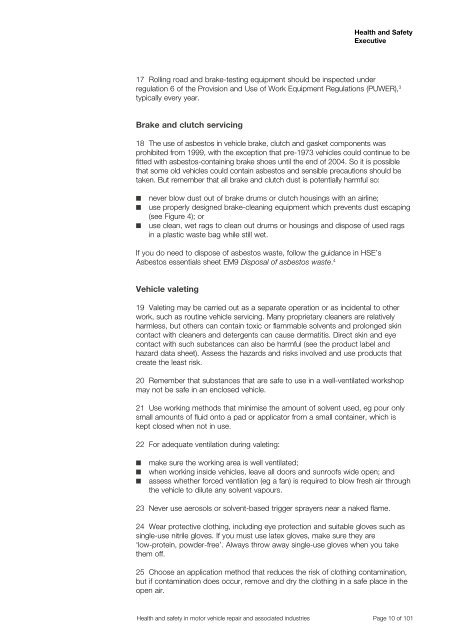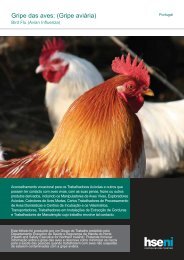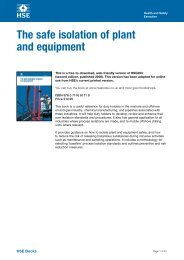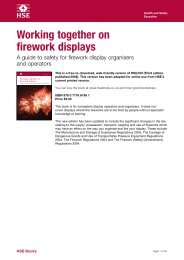Health and safety in motor vehicle repair and associated industries
Health and safety in motor vehicle repair and associated industries
Health and safety in motor vehicle repair and associated industries
Create successful ePaper yourself
Turn your PDF publications into a flip-book with our unique Google optimized e-Paper software.
<strong>Health</strong> <strong>and</strong> Safety<br />
Executive<br />
17 Roll<strong>in</strong>g road <strong>and</strong> brake-test<strong>in</strong>g equipment should be <strong>in</strong>spected under<br />
regulation 6 of the Provision <strong>and</strong> Use of Work Equipment Regulations (PUWER), 3<br />
typically every year.<br />
Brake <strong>and</strong> clutch servic<strong>in</strong>g<br />
18 The use of asbestos <strong>in</strong> <strong>vehicle</strong> brake, clutch <strong>and</strong> gasket components was<br />
prohibited from 1999, with the exception that pre-1973 <strong>vehicle</strong>s could cont<strong>in</strong>ue to be<br />
fitted with asbestos-conta<strong>in</strong><strong>in</strong>g brake shoes until the end of 2004. So it is possible<br />
that some old <strong>vehicle</strong>s could conta<strong>in</strong> asbestos <strong>and</strong> sensible precautions should be<br />
taken. But remember that all brake <strong>and</strong> clutch dust is potentially harmful so:<br />
n<br />
n<br />
n<br />
never blow dust out of brake drums or clutch hous<strong>in</strong>gs with an airl<strong>in</strong>e;<br />
use properly designed brake-clean<strong>in</strong>g equipment which prevents dust escap<strong>in</strong>g<br />
(see Figure 4); or<br />
use clean, wet rags to clean out drums or hous<strong>in</strong>gs <strong>and</strong> dispose of used rags<br />
<strong>in</strong> a plastic waste bag while still wet.<br />
If you do need to dispose of asbestos waste, follow the guidance <strong>in</strong> HSE’s<br />
Asbestos essentials sheet EM9 Disposal of asbestos waste. 4<br />
Vehicle valet<strong>in</strong>g<br />
19 Valet<strong>in</strong>g may be carried out as a separate operation or as <strong>in</strong>cidental to other<br />
work, such as rout<strong>in</strong>e <strong>vehicle</strong> servic<strong>in</strong>g. Many proprietary cleaners are relatively<br />
harmless, but others can conta<strong>in</strong> toxic or flammable solvents <strong>and</strong> prolonged sk<strong>in</strong><br />
contact with cleaners <strong>and</strong> detergents can cause dermatitis. Direct sk<strong>in</strong> <strong>and</strong> eye<br />
contact with such substances can also be harmful (see the product label <strong>and</strong><br />
hazard data sheet). Assess the hazards <strong>and</strong> risks <strong>in</strong>volved <strong>and</strong> use products that<br />
create the least risk.<br />
20 Remember that substances that are safe to use <strong>in</strong> a well-ventilated workshop<br />
may not be safe <strong>in</strong> an enclosed <strong>vehicle</strong>.<br />
21 Use work<strong>in</strong>g methods that m<strong>in</strong>imise the amount of solvent used, eg pour only<br />
small amounts of fluid onto a pad or applicator from a small conta<strong>in</strong>er, which is<br />
kept closed when not <strong>in</strong> use.<br />
22 For adequate ventilation dur<strong>in</strong>g valet<strong>in</strong>g:<br />
n<br />
n<br />
n<br />
make sure the work<strong>in</strong>g area is well ventilated;<br />
when work<strong>in</strong>g <strong>in</strong>side <strong>vehicle</strong>s, leave all doors <strong>and</strong> sunroofs wide open; <strong>and</strong><br />
assess whether forced ventilation (eg a fan) is required to blow fresh air through<br />
the <strong>vehicle</strong> to dilute any solvent vapours.<br />
23 Never use aerosols or solvent-based trigger sprayers near a naked flame.<br />
24 Wear protective cloth<strong>in</strong>g, <strong>in</strong>clud<strong>in</strong>g eye protection <strong>and</strong> suitable gloves such as<br />
s<strong>in</strong>gle-use nitrile gloves. If you must use latex gloves, make sure they are<br />
‘low-prote<strong>in</strong>, powder-free’. Always throw away s<strong>in</strong>gle-use gloves when you take<br />
them off.<br />
25 Choose an application method that reduces the risk of cloth<strong>in</strong>g contam<strong>in</strong>ation,<br />
but if contam<strong>in</strong>ation does occur, remove <strong>and</strong> dry the cloth<strong>in</strong>g <strong>in</strong> a safe place <strong>in</strong> the<br />
open air.<br />
<strong>Health</strong> <strong>and</strong> <strong>safety</strong> <strong>in</strong> <strong>motor</strong> <strong>vehicle</strong> <strong>repair</strong> <strong>and</strong> <strong>associated</strong> <strong>in</strong>dustries Page 10 of 101







